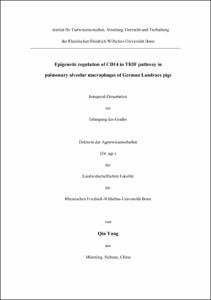Online-Ausgabe in bonndoc: https://nbn-resolving.org/urn:nbn:de:hbz:5n-43683
urn: https://nbn-resolving.org/urn:nbn:de:hbz:5n-43683,
author = {{Qin Yang}},
title = {Epigenetic regulation of CD14 in TRIF pathway in pulmonary alveolar macrophages of German Landrace pigs},
school = {Rheinische Friedrich-Wilhelms-Universität Bonn},
year = 2016,
month = may,
volume = 181,
note = {Diseases of the respiratory system are a main problem in pig production. Pulmonary alveolar macrophages (PAMs) are key players to defend these respiratory diseases like lung inflammation caused by bacterial infection. Cluster of differentiation 14 (CD14) is the pattern recognition receptor (PRR) involved in the recognition of bacterial component lipopolysaccharide (LPS) through the MyD88-dependent and TRIF pathway of innate immunity. Gene expression regulation of CD14 and downstream genes may prevent LPS-induced inflammation in pigs. However, epigenetic modulation on gene expression of CD14 in response to infection is poorly understood. As a histone deacetylase (HDAC) inhibitor, sulforaphane (SFN) shows an anti-inflammatory activity and suppresses the DNA methylation. To identify the epigenetic changes of CD14 mediated with SFN in LPS-induced TRIF pathway, a PAMs model in vitro was investigated. For this, mRNA expression of CD14 and downstream genes of TRIF pathway were quantified using qPCR. The cytokine level of tumor necrosis factor-α (TNFα) and interleukin-1β (IL-1β) were measured by enzyme - linked immunosorbent assay (ELISA). The protein level of NF-κB was analyzed by Western blot. In addition, gene expression of the epigenetic enzymes DNA methyltransferase-1 (DNMT1) and DNMT3a were quantified. Furthermore, the DNA methylation alterations of CD14 at promotor and gene body (CDS region) were analyzed using bisulfite sequencing in SFN and LPS treated PAMs.
We found that CD14 gene expression was induced by 5 µg/mL LPS in time dependent manner. At time point 12 h, the gene expression of CD14 and downstream genes in TRIF pathway including TRIF, TRAF6, NFƳB, TRAF3, IRF7 and cytokines such as TNF-α, IL-1β, IL-6 and IFN-β were significantly induced by LPS. The LPS induced gene expression was suppressed by SFN in a dose dependent manner. The LPS-induced cytokine level of TNFα, IL-1β and NF-κB were also inhibited by SFN. Similarly, the DNMT3a mRNA expression was increased by LPS and down regulated by SFN at a dose of 5 µM. Furthermore, the bisulfite sequencing results presented that gene body methylation of CD14 was positively associated with gene expression of LPS treated PAMs and this methylation status was inhibited by SFN in a dose dependent manner. This in vitro study suggests that CD14 is involved in TRIF pathway including TRIF-TRAF6 and TRIF-TRAF3 pathway by LPS induction. Further, this LPS-CD14 activation was suppressed by SFN via the epigenetic regulation of CD14 gene body methylation associated with DNMT3a.
This study provided novel insights into SFN-mediated epigenetic downregulation of CD14 gene in LPS induced-TRIF pathway inflammation and may open new avenues of approaches to prevent and mitigate the LPS-induced inflammation in pigs},
url = {https://hdl.handle.net/20.500.11811/6612}
}






